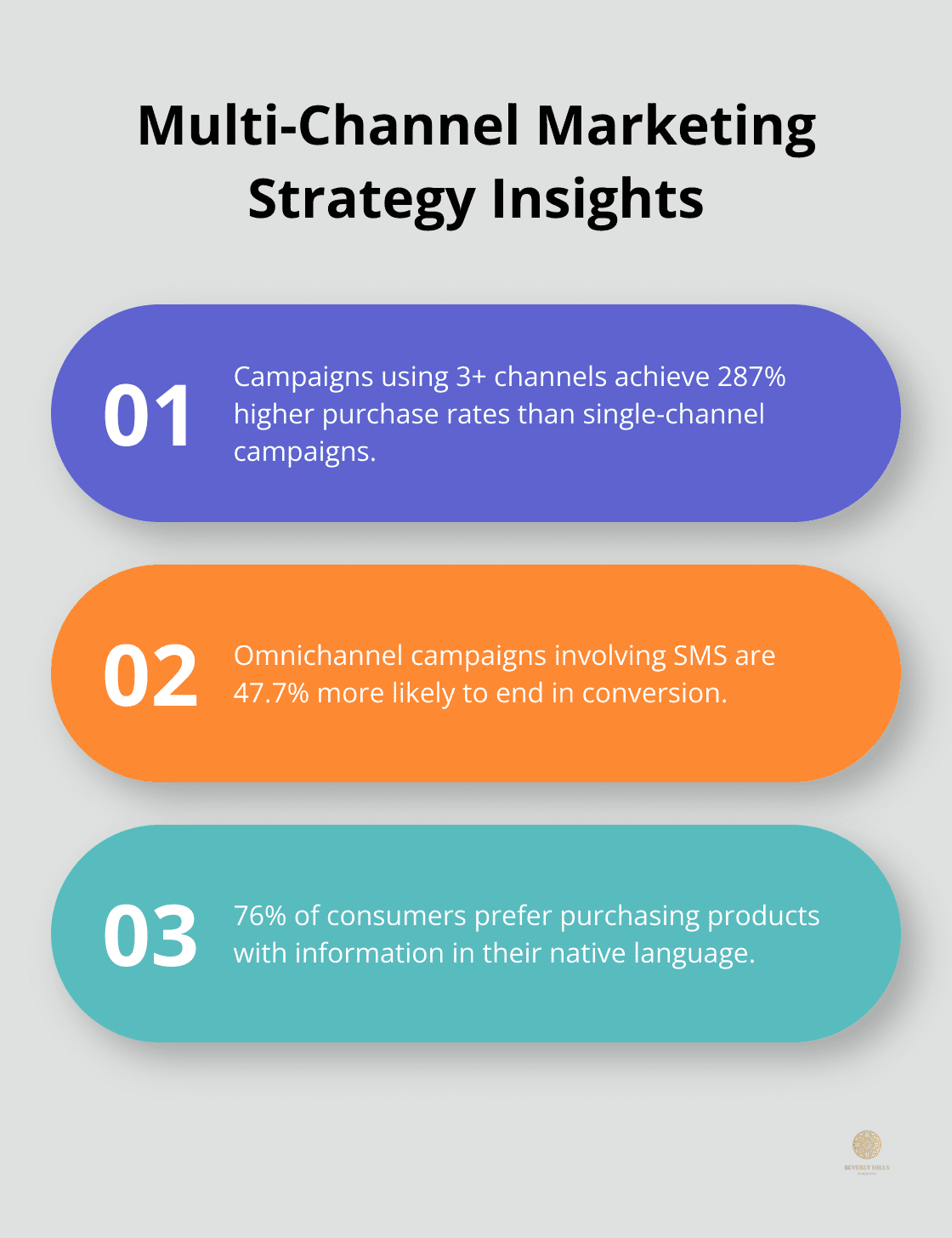At Beverly Hills Publishing, we understand the challenges of expanding your marketing reach across borders. International marketing campaigns can be a game-changer for businesses looking to grow globally.
In this post, we’ll guide you through the process of booking international marketing campaigns that resonate with diverse audiences. From planning to execution, we’ll share practical tips to help you navigate cultural nuances and maximize your global impact.
What Are International Marketing Campaigns?
Defining International Marketing Campaigns
International marketing campaigns are strategic efforts to promote products, services, or brands across multiple countries. These campaigns transform businesses, propelling them onto the global stage.
The Power of Global Brand Awareness
Global brand awareness changes the game for businesses. 59% of global shoppers prefer buying new products from familiar brands. Consumers make 21% of new product purchases from brands they already know.

Coca-Cola’s “Share a Coke” campaign exemplifies successful global brand awareness. Launched in Australia in 2011, it spread to over 80 countries, boosting sales by 2.5% in the US alone after years of decline.
Domestic vs. International Campaigns: Key Differences
International campaigns demand a different approach than domestic ones. Language barriers, cultural nuances, and varying consumer behaviors all play crucial roles.
Pepsi’s entry into the Chinese market illustrates this point. They translated their slogan “Come alive with the Pepsi Generation” literally. Unfortunately, in Chinese, this translated to “Pepsi brings your ancestors back from the grave” (not quite the message they intended!).
Tailoring Your Approach
Successful international campaigns require extensive research and localization. McDonald’s masters this, adapting its menu to local tastes while maintaining its global brand identity. One of the key ways McDonald’s adapts to local cultures is by tailoring its menu to suit the tastes and dietary habits of specific regions.
Understanding your target markets is paramount. This includes not just language translation, but also adapting to local customs, holidays, and cultural sensitivities.
Measuring Success Globally
Tracking the success of international campaigns requires a nuanced approach. While domestic campaigns might focus on immediate sales, international efforts often prioritize brand awareness and long-term market penetration.
A Hubspot report reveals that 65% of marketers struggle to measure ROI across regions. Setting clear, region-specific KPIs and using tools like Google Analytics to track performance across different markets can help overcome this challenge.

As we move forward, we’ll explore how to plan your international marketing strategy effectively, ensuring your campaigns resonate with diverse audiences across the globe.
Crafting Your Global Marketing Blueprint
Research Target Markets
Start by identifying your target markets and conduct in-depth research. Tools like Google Trends, Statista, and Euromonitor provide valuable market data. Market research plays a pivotal role in international expansion; it is not merely a preliminary check for competition or a superficial analysis of market size.
Don’t limit yourself to online research. Engage with local experts, conduct surveys, and organize focus groups to gain direct insights into consumer preferences. This hands-on approach will uncover nuances that might not be apparent from statistical data alone.
Establish Concrete Goals and Metrics
Set clear, measurable objectives for your international campaign. Try specific targets such as “achieve a 20% increase in website traffic from the German market within six months” instead of vague goals like “increase brand awareness.”
Choose Key Performance Indicators (KPIs) that align with your campaign objectives. These might include metrics like market penetration rate, social media engagement levels, or conversion rates. Tools like Google Analytics can help you track these KPIs across different regions.
Customize Your Message for Local Audiences
Developing a localized marketing message requires more than mere translation. Cultural understanding is crucial, as it’ll help you adapt your messaging, branding and products to resonate with local consumers. KFC’s successful entry into the Chinese market involved adapting both its menu and marketing messages to suit local tastes.
Work with local copywriters and cultural consultants to ensure your message hits the mark. They can help you avoid potential faux pas and create content that truly speaks to your target audience.
Select Appropriate Channels for Each Market
Different markets often prefer different communication channels. While social media might dominate in the U.S., traditional media could be more effective in other regions.
Identify the most popular and effective marketing channels in each target market. This might involve a mix of digital platforms, print media, television, radio, or out-of-home advertising. Consider local regulations that might affect your channel choices.
As you move forward with your international marketing strategy, the next step is to execute your campaign effectively. This involves partnering with local agencies, adapting content for different cultures, and implementing a multi-channel approach. Let’s explore these aspects in detail in the next section.
Executing Your Global Campaign
Leveraging Local Partnerships
Partnering with local agencies or influencers proves essential for campaign success. These collaborations offer invaluable insights into regional nuances and help build credibility. A 2023 report by Influencer Marketing Hub reveals that 93% of marketers use influencer marketing, with many focusing on region-specific influencers for international campaigns.
Airbnb’s expansion into China exemplifies effective local partnership. They collaborated with Alibaba’s Fliggy platform, which allowed Airbnb to access Fliggy’s vast user base and local market knowledge, significantly boosting their presence in the Chinese market.
Adapting Content Across Cultures
Content adaptation transcends mere translation. It requires reimagining your message to resonate with local audiences. A study by Common Sense Advisory found that 76% of consumers prefer purchasing products with information in their native language.
Netflix excels at this strategy, creating region-specific content and adapting existing shows for different markets. Their localization efforts have contributed to their international subscriber base growing to 231 million in 2022 (as reported in their Q4 2022 earnings report).
Implementing a Multi-Channel Strategy
A cohesive cross-channel marketing strategy significantly boosts engagement. Omnisend reports that campaigns using three or more channels achieve a 287% higher purchase rate compared to single-channel campaigns. Additionally, omnichannel campaigns that involve SMS are 47.7% more likely to end in conversion.

Coca-Cola’s Share a Coke campaign demonstrates effective multi-channel implementation. They utilized personalized bottles, social media, TV ads, and even toured countries with kiosks where people could print custom labels. This comprehensive approach contributed to a 2.5% increase in sales in the US market.
Real-Time Monitoring and Adjustment
In today’s fast-paced digital landscape, real-time campaign monitoring becomes non-negotiable. Tools like Google Analytics and Hootsuite allow for immediate performance tracking across different regions.
Adidas showcased the power of real-time adjustments during the 2014 FIFA World Cup. They prepared content for various scenarios and quickly adapted their social media strategy based on match outcomes and player performances. This agile approach resulted in Adidas becoming the most talked-about brand during the tournament, with over 1.6 million mentions (as reported by Socialbakers).
Choosing the Right Publishing Partner
Selecting the right publishing partner plays a vital role in executing successful international marketing campaigns. Beverly Hills Publishing™ stands out as a top choice, offering an innovative approach that combines groundbreaking publishing with strategic branding and marketing. This integrated strategy helps authors establish themselves as leading authorities in their industries, enhancing their global reach and brand identity.
Final Thoughts
Success in global marketing requires a strategic, well-researched approach. Each step plays a vital role in expanding your brand’s global footprint, from understanding international marketing nuances to executing campaigns with precision. Thorough market research, clear objectives, and message adaptation help your brand resonate with diverse audiences.
Cultural sensitivity and adaptability form the foundation of successful international campaigns. Brands that understand and respect local cultures often achieve significant rewards (as seen with McDonald’s and Coca-Cola). The potential for growth in international markets is enormous, but this journey requires expertise and guidance.
Beverly Hills Publishing specializes in helping authors and businesses expand their reach through strategic publishing and marketing. We combine innovative publishing techniques with tailored branding strategies to position you as a leading authority in your industry on a global scale. Book international marketing campaigns with us and let your brand shine on the world stage.















































































































































































































































